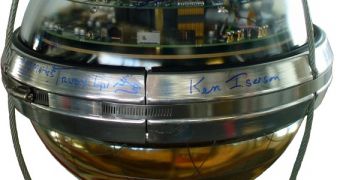Physicists with the IceCube Collaboration – which operates the IceCube Neutrino Observatory in Antarctica – announce the discovery of three neutrinos that are easily among the highest-energy elementary particles of this type ever identified. The team believes that these particular neutrinos may have been produced by a distant supernova blast.
Data recorded by the 4,800 Digital Optical Modules (DOM) making up the detector suggests that the neutrinos have ridiculous energy levels, in the petaelectronvolt range, which is the rough equivalent of a million times the mass of a single proton. This is an extremely high level of energy, meaning that the source which released these particles must have been a very energetic event in its own right.
Physicists with the IceCube Collaboration called the first two neutrinos Ernie and Bert and presented them to the world last year, when the detector announced its first accurate detections of neutrinos from cosmic sources. On Monday, April 7, scientists presented the third neutrino, known among its discoverers as Big Bird, at the annual meeting of the American Physical Society.
As their names suggest, these elementary particles seldom interact with other particles, preferring to keep to themselves. They have no mass to speak of and a neutral electrical charge, meaning that they can even theoretically escape the immense gravitational pull of a black hole. Trillions of neutrinos pass through our bodies every second, but interactions with our cells will likely never occur.
In order to maximize its chances of detecting the rare occasions when neutrinos do interact with other particles, IceCube was built inside a cubic kilometer of ice buried underneath the South Pole. This location serves the purpose of protecting the detector against stray radiations of any kind from Earth, but it also helps weed out some of the other types of cosmic rays that may produce false results.
University of Wisconsin–Madison (UWM) IceCube physicist Chris Weaver explains that, since these particles are not influenced by magnetic fields, they never change direction. As such, tracing back their trajectory at detection should point exactly to its place of origin. Scientists want to use this capability to discover nearly invisible distant galaxies and clusters in the early Universe.
The most likely origins for high-energy neutrinos are quasars, active galactic nuclei, binary systems or galaxies featuring black holes that feed at intense paces, gamma-ray bursts, and stellar nurseries that are in an intense process of stellar formation. Now that these particles have been actually proven to exist, astrophysicists can begin to search for these interesting phenomena.
“It looks like we have reached compelling evidence for astrophysical neutrinos” in late 2013, UWM physicist and IceCube Collaboration member Albrecht Karle said at the conference, as quoted by Nature News.

 14 DAY TRIAL //
14 DAY TRIAL //